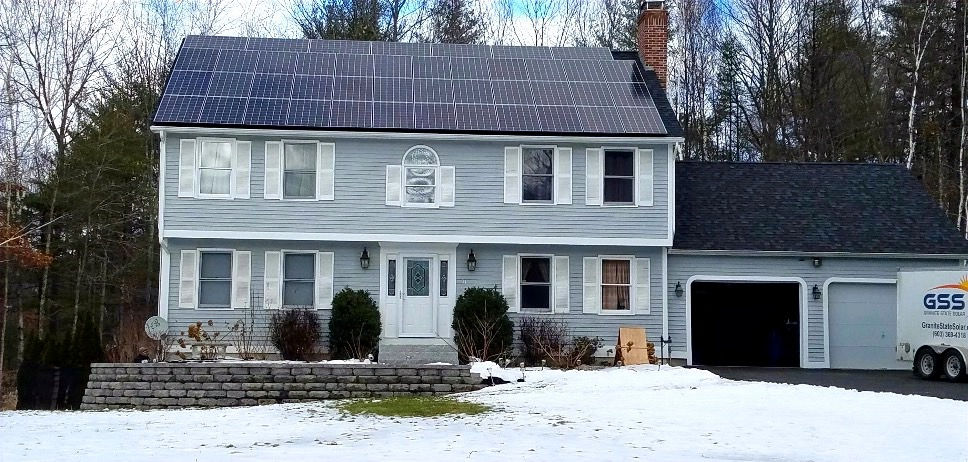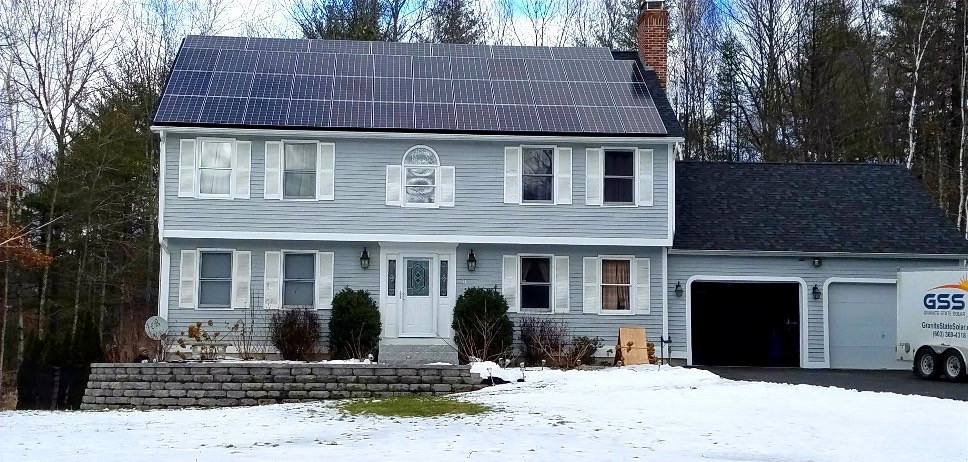How Do I Get Snow Off my Solar Panels?

Updated: Jan 12
New Hampshire winters mean business, but how does that snow impact solar panels?

Depending on where you live, Granite Staters see anywhere from 50 inches of snow annually (on the coast) to upwards of 200 inches of snow on the snowiest mountains. But the good news: A properly sized solar system will take your snow into consideration—and you can still come out ahead. Let’s start with an early season dusting. “The panels will still produce with some snow on them,” says Zach Olster, field operations director for Granite State Solar. Two to three inches will slow down production, but not stop it entirely.
But for bigger storms, do you need to try to shovel snow off of your panels? The good news is that the answer is no: compared to a regular asphalt single roof, they'll shed the snow much better on their own. “The panels will do a good job of shedding snow themselves,” says Zach. “While they don't have a built-in heating element, they heat up pretty well—most are either black or blue-faced panels, so they do attract sunlight to them.” Plus, any heat loss through your attic will help warm things up even before the sun starts shining.
He describes having solar similar to having a metal roof: “If a customer has a metal roof, they’re pretty used to how the snow falls off pretty quickly,” he says. “It’s going to be pretty similar to that experience. It’ll be a lot quicker than a normal asphalt roof would, so it shouldn’t be a huge concern.” (Similar to a metal roof, Zach does recommend being careful if your panels are over doorways and monitoring for falling snow. “And if it’s over your garage, keep in mind where you park your vehicle.”)
How Solar Panels Shed Snow
Effective snow shedding starts with smart design. “For the roofs, we put the panels one shingle-line up,” says Zach. “If you leave too much room, then the snow’s going to shed off the panels but there’s a good chance the snow’s going to stop on the asphalt shingles. In that case, it’s going to keep building up and up and build an ice dam, which is no good for your roof.”
Even for ground mounts, Granite State Solar keeps snow in mind. “With our ground mounts, we’ll leave them a minimum of 36 inches from the lowest point to allow room for snow to shed,” he explains.
Another aspect of smart design is picking the right the inverter technology. Because of the microinverters we use, snow on one part of your array won’t hurt production on a section that’s clear of snow. String inverters, on the other hand, don’t have this benefit. Think of it like Christmas lights—if one bulb goes out, the others go out. It’s a similar problem with string inverters: if one panel is under performing, all of the panels are hampered. Having the right product from the start ensures that your system won’t slow down if one part of your roof is snowier than another.
Finally, snow isn’t a huge concern if the system is designed to take a few snow days into consideration. Granite State Solar understands that, in New Hampshire, most of your solar generation—and net metering credits—come from the summer, so your system is designed for peak summer performance. That means that even if you lose a few days or more in the winter, your system will still offset your energy usage when you look at the big picture of the entire year.
How to Get Snow off Panels: Dos and Don’ts
While Zach’s expert opinion is that the few bucks you save trying to get snow off your system isn’t worth the hassle (or danger—to you or your panels), he can’t blame people for trying. If you’re determined, make sure you’re doing it the right way.
For starters, pick the right tool. “You don’t want to go with plastic because you don’t want to scratch your panels,” warns Zach. Consider trying a rubber- or sponge-edged roof rake with a telescoping pole.
And he doesn’t recommend pulling out the ladder to try to climb your roof in the winter. With the ice, it’s just too dangerous. (Yes, Granite State Solar installs solar panels in the winter, but they’re wearing safety harnesses!) A telescoping pole that can reach your roof is the safest option. In fact, it doesn’t even have to reach the peak of your home. Zach says aiming for that first shingle line is right at the base of your panels can be effective. “If you can clear that area, it gives it the snow a way to freely come off instead of getting caught up,” he says. Again, you’re not going to get a huge ice dam because it’s such a small area, but it’s low hanging fruit if you’re so inclined.
By Julia Westbrook

Leave a Comment